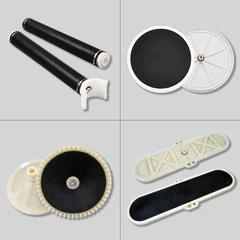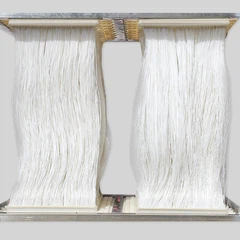
Introduction
In wastewater treatment, the aeration diffuser selection leads to oxygen transfer, operational stability, and cost control. The two most common types are fine bubble and coarse bubble disc diffusers. While both supply air to the biological process, they suit different plants' specific conditions and treatment goals.
Choosing the wrong type can be costly. For wholesale buyers, it may lead to increased returns and complaints, and harm your business reputation. For plant engineers, it can affect system performance, raise maintenance costs, and create operational risks. This article breaks down the differences to help you pick the right solution. So in this article, we'll offer a clear comparison of them, to help you choose the one right for you.
Fine Bubble & Coarse Bubble Disc Diffuser: What Are They?

Fine Bubble Disc Diffuser
A fine bubble disc diffuser produces microbubbles typically less than 3 mm in diameter. Compressed air passes through an EPDM or silicone membrane with precision-drilled perforations. These microbubbles rise slowly through the water column, greatly increasing oxygen–water contact time and improving oxygen transfer efficiency (OTE).

Coarse Bubble Disc Diffuser
A coarse bubble disc diffuser releases larger bubbles, between 4~13 mm in diameter, through openings in a rigid or semi-rigid structure. These bubbles rise quickly, creating strong mixing currents.
Pros and Cons of Fine Bubble Disc Diffusers
Pros:
- High Oxygen Transfer Efficiency: Field SOTE typically reaches 20~35%, higher than coarse bubble systems (10~20%), enabling smaller blower capacity or reduced air volume.
- Energy Savings: In a 10,000 m³/d municipal WWTP, fine bubble diffusers can reduce aeration energy consumption by 20~30% annually.
- Uniform Oxygen Distribution: Improves biological stability, reduces dead zones, and enhances process control precision, especially in nutrient removal systems.
- Stable Performance in Continuous Operation: Well-suited for plants running 24/7 with automated dissolved oxygen (DO) control.


Cons:
- Prone to clogging: Particularly in high FOG (fats, oils, grease) or high suspended solids wastewater.
- Higher Air Pressure Requirement: Typically operates at 0.5~0.8 bar, demanding more from blowers.
- More Frequent Maintenance: Membranes typically need replacement every 3~5 years.
Pros and Cons of Coarse Bubble Disc Diffusers
Pros:
- Excellent Anti-clogging Performance: It prevents fouling with its rigid structure, suiting for industrial wastewater with high oil, grease, or solids. → lower operating cost
- Long Maintenance Cycle: Service life of 5~8 years, even up to 10 years in clean applications.
- Low-pressure Operation: Only 0.3~0.5 bar, making it suitable for retrofitting older systems with limited blower capacity.


Cons:
- Lower Oxygen Transfer Efficiency: Only 10~20%, leading to higher energy use in processes requiring strict BOD/ammonia removal.
- Less Precise Aeration Control: Not suitable for automated, high-precision processes.
- High Airflow Demand: Requires larger blowers and piping, increasing initial investment./li>
If you are unsure how to calculate based on on-site parameters, please contact our engineering team for customized air volume and model selection recommendations.
Fine Bubble vs. Coarse Bubble Disc Diffuser: Side-by-Side Comparison
|
Feature |
Fine Bubble |
Coarse Bubble |
|
Bubble Size |
< 3 mm |
4~13 mm |
|
SOTE |
20~35% |
10~20% |
|
Airflow Requirement |
Low |
High |
|
Pressure Requirement |
0.5~0.8 bar |
0.3~0.5 bar |
|
Clogging Risk |
Higher |
Very low |
|
Maintenance Cycle |
3~5 years |
5~8+ years |
|
Energy Efficiency |
High |
Moderate |
|
Mixing Capability |
Moderate |
Strong |
Typical Use Cases and Recommendations
Municipal Wastewater Treatment Plants –
Activated Sludge Tanks & Contact Oxidation Tanks
Recommended Models: AS-DD215, AS-DD270, AS-DD350.
Why:
- High oxygen transfer efficiency with wide service coverage, suitable for aeration tanks of various scales.
- Anti-clog and anti-buoyancy designs extend service life, reducing downtime and maintenance costs.
SBR (Sequencing Batch Reactor) Tanks
Recommended Models: AS-DD215, AS-DD270, AS-DD350. (Selected based on tank volume and aeration rate)
Why:
- Compatible with intermittent operation cycles of SBR processes.
- Maintains stable oxygen transfer efficiency, ensuring consistent treatment performance even under variable loading conditions.
Aerobic Stage for Nitrogen and Phosphorus Removal
Recommended Type: Fine Bubble Silicone Disc Diffusers
Why:
- Produces fine, uniform bubbles for maximum oxygen transfer, enhancing nitrification and denitrification processes in high-strength wastewater treatment applications.
Livestock and Agricultural Wastewater Treatment
Recommended Type: Coarse Bubble EPDM Rubber Disc Diffusers.s
Why:
- Excellent corrosion resistance, tear strength, and clogging resistance.
- Designed for high-organic-load wastewater, ensuring stable aeration in challenging conditions.
Deep Aeration Tanks
Recommended Models: Large-size Disc Diffusers such as AS-DD350.
Why:
- Strong deep-water aeration capacity, effectively increasing dissolved oxygen in deeper water layers, boosting microbial activity and treatment efficiency.
Aquaculture Systems
Recommended Type: Fine Bubble Ceramic or Nylon Disc Diffusers.
Why:
- High oxygenation efficiency with ultra-fine bubbles.
- Operates quietly without disturbing aquatic species, creating an optimal environment for fish and shrimp growth.
How to Choose Between Fine and Coarse Bubble Disc Diffusers
Selecting the right diffuser type depends on multiple practical factors related to wastewater characteristics, treatment goals, operational costs, and maintenance capabilities. Below are what to consider:
1. Influent Water Quality
High solids, oils, grease, and fibrous content → Favor coarse bubble disc diffusers, which are more resistant to fouling and clogging due to their larger bubble size and robust membrane structure.
Low to moderate solids, cleaner influent → Fine bubble disc diffusers are ideal, as their microbubbles provide higher oxygen transfer efficiency under less challenging conditions.
2. BOD/TSS Removal Targets
Plants aiming for strict biochemical oxygen demand (BOD) and total suspended solids (TSS) limits require highly efficient oxygen transfer. Here, we choose fine bubble diffusers due to their higher oxygen dissolution capacity.
Where effluent requirements are less stringent or the wastewater is heavily loaded, coarse bubble diffusers may suffice with easier maintenance.
3. Energy Budget
If energy efficiency and lower operational costs are priorities, especially in large-scale or continuous operations, fine bubble diffusers can reduce blower energy consumption by 20~30%, offering savings over the system lifecycle.
4. Maintenance Resources
Facilities with limited maintenance staff or constrained downtime should consider coarse bubble diffusers, which require less frequent cleaning and membrane replacement. Fine bubble diffusers offer performance benefits but need regular inspection and membrane upkeep.
Summary Flow:
- High solids/oil + limited maintenance → Coarse bubble diffuser
- Strict discharge limits + energy savings priority → Fine bubble diffuser
- Balanced scenario → Consider influent variability and budget constraints
Conclusion
Choosing between fine and coarse bubble disc diffusers depends on your wastewater characteristics, oxygen demand, energy budget, and maintenance capabilities. Fine bubble diffusers deliver energy savings and precise control, suitable for municipal plants with high treatment standards. Coarse bubble diffusers offer durability and low maintenance, better for industrial and challenging wastewater environments.
Get Your Custom Diffuser Solution
Looking to optimize your aeration efficiency and reduce operational costs? Request a free consultation now to find out the customized diffuser that suits your plant's needs and budget best. AquaSust's technical experts are here ready to discuss your wastewater treatment needs, with a detailed specification and quote.




















